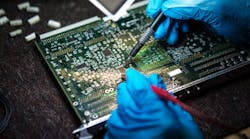Arm said it plans to launch a 5G lab with the support of several major semiconductor vendors and other players, giving them a place to test new technologies and plot out strategies for bringing them to market.
The company detailed its plan for the new 5G Solutions Lab ahead of its annual conference on Monday. Arm said it would allow companies to work together to test and validate 5G solutions in areas ranging from small cells and macrocells to core networks and software in charge of coordinating all of the base stations in a telecom giant's 5G network. The lab could also focus on new network architectures including cloud RAN.
Arm executives said 5G networks have already been deployed in 60 markets globally. Moreover, 5G phones are on pace to represent 40% of global shipments in 2021, growing to almost 70% by 2025, according to IDC.
"The rapid pace of deployment underscores how critical it is that we achieve faster development of network and edge infrastructure solutions," said Chris Bergey, SVP and GM of Arm's infrastructure business, in a blog.
Arm plans to open the 5G labs' doors as many telecom giants overhaul how they operate new 5G networks. Many telecom firms are investing in a new standard for open radio access networks called Open RAN, which will allow them to use more commodity networking gear in 5G networks. This model mirrors the "white box" systems widely used by Amazon, Google, Microsoft and other cloud players for software-defined networks.
Previously, telecom giants would buy all of the components necessary to build a base station from a single supplier such as Nokia, Ericsson or Huawei, each with proprietary packages of hardware and software that limited their customers' flexibility. But the Open RAN standard would make it possible for them to mix and match interchangeable components sold by different vendors and assemble them in a more modular way.
The Open RAN model could also reduce costs by bringing more competition to the market. By giving telcos the ability to add features to 5G networks by upgrading the software or swapping out standard hardware, Nokia, Ericsson, Samsung, Cisco and other telecom gear vendors will have to compete more on pricing.
Arm proposed the 5G solutions lab as a place for hardware and software vendors to test new products against each other to make sure that they are interchangeable and meet 5G standards like Open RAN.
Arm said the lab is supported by a wide range of industry partners, including Nvidia, NXP Semiconductors, Marvell and Qualcomm, which has been investing to expand its footprint in the market for 5G base station silicon. Google's cloud computing arm plans to take part in the 5G technology lab, along with more than 10 other networking gear makers, software firms, and telecom giants such as Dish Networks and Vodaphone.
Bergey said the lab would give them a place to collaborate on blueprints for end-to-end systems, set performance goals and create strategies for bringing 5G innovations to market faster.
Arm plans to play a central role in the market for 5G network infrastructure, with Arm-based chips inside the majority of base stations. Arm is also dominant in smartphones that can connect to 5G networks.
Arm plans to launch the lab in early 2022.
This article appeared in Electronic Design.








